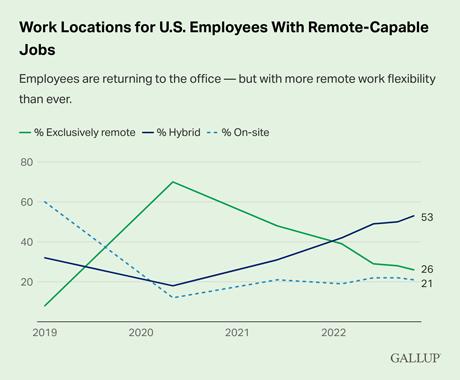Story Highlights
- Hybrid strategies should adapt to meet business and employee needs
- Hybrid work improves work-life balance, efficiency and autonomy
- The office is still the best place for employees to work collaboratively
The Situation:
Employees are returning to the office in droves, and hybrid work arrangements are quickly becoming the new normal for many remote-capable employees.
Employers are scrambling to determine how to make hybrid work as engaging and productive as possible.
Crafting an effective hybrid strategy, work environment and culture begins with leaning into what's working, adjusting what's not working and adapting as lessons are learned.
Key Questions:
Using a nationally representative sample of 8,090 remote-capable employees, we studied how hybrid workers -- who spend part of their week in-office and part working remotely -- are experiencing their new work environment after returning to the office from pandemic restrictions.
In our quest to better understand what is working and what needs to be improved in these hybrid work environments, we examined two key questions:
- What are the advantages and challenges of hybrid work?
- How are hybrid workers spending their time on-site versus at home?
The Findings:
Insight No. 1:
What are the advantages and challenges of hybrid work?
The greatest advantages of hybrid work to date are: improved work-life balance, more efficient use of time, control over work hours and work location, burnout mitigation, and higher productivity.
- Hybrid work provides the flexibility for employees to work in ways that are most effective for them.
- Employees believe their current hybrid arrangements improve their personal wellbeing and productivity at work.
- Hybrid individual contributors, managers and senior leaders closely agree on both the top advantages and disadvantages of hybrid work -- signifying more common ground in organizations than might be expected.
The greatest challenges of hybrid work include: having the right tools to be effective at work, feeling less connected to the organization's culture, impaired collaboration and relationships, and disrupted work processes.
- Hybrid work is creating a need for better coordination of resources, both at home and on-site. Home offices now need to be fully functional, permanent workstations that maximize personal productivity. On-site offices and conference rooms need to be remote-capable collaboration stations so remote participants are fully included in team interactions.
- While organizational culture is substantially more difficult to cultivate in a fully remote environment, hybrid work still presents its challenges as people working remotely intermittently throughout the week will feel disconnected at times.
- Similarly, teamwork and relationships will be challenged in new ways. Hybrid work creates the opportunity to spend meaningful time together in the office collaborating and building relationships. However, hybrid work also requires more extensive coordination of meetings and schedules, from determining when others are available and in the office to figuring out how to lead hybrid meetings with part of the audience online.
- Notably, the top challenges of hybrid work are far less prevalent than the top advantages. This indicates that the greatest advantages of hybrid work substantially outweigh the biggest challenges.
Insight No. 2:
How are hybrid workers spending their time on-site versus at home?
When working on-site, employees prioritize: collaborating with colleagues, connecting with their manager and using technology that is unique to that location.
- Hybrid workers are spending their time on-site addressing the aforementioned top challenges of being away from the office part of the week -- deep collaboration, resource utilization and relationship-building.
- It's important that managers help employees be very intentional about making good use of their time on-site. They should be encouraged to spend time with teammates, network with colleagues from different teams and use the equipment best leveraged on-site.
- In contrast, forcing everyone into the office just to take Zoom calls and do independent work tasks they were doing from their living room in pajama pants will not be a welcome use of time for most hybrid workers.
When working from home, hybrid workers are primarily focused on: head-down, independent work tasks -- away from the distractions of the office.
- Time at home helps hybrid workers efficiently drive personal performance while allowing for the flexibility to meet other life responsibilities, such as running errands or taking children to school and activities.
- This time to focus on personal work tasks and responsibilities may become even more important as employees spend more of their time on teamwork and relationship-building when on-site.
- As a cautionary insight, hybrid employees are not spending much WFH time with their manager, so feedback, recognition and development may primarily be isolated to in-person interactions. These important employee needs are low on the list of hybrid work advantages -- but also are not flagged as major challenges, suggesting they may be falling off the radar for some employees and managers.
What Leaders Should Do Next:
The art of hybrid work largely comes down to leveraging the advantages it creates, quickly addressing its challenges and being very intentional about how time is spent on-site versus at home.
Start by asking your team members what's working, what's not, and what's most effective for them -- and then track how those answers change with time and repetition. Ask questions like:
- Describe the work you do that can be done independently.
- Describe the work you do that is better when we work together.
- What happens when we are in person together that doesn't when we work from home?
- Describe the times when our team works best with other teams.
- Describe the times when you feel connected to our team's culture.
- How do we build some predictability in our work schedules so in-person time is maximized?
- Describe the times when we have created exceptional value for our customers.
To build a hybrid work strategy:
- Learn more about what makes a solid hybrid work strategy for employees and organizations.
- Contact Gallup to discuss building a culture where hybrid work succeeds.




